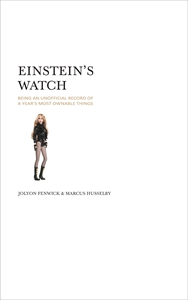
Einstein’s Watch: Being an Unofficial Record of a Year’s Most Ownable Things
by Jolyon Fenwick & Marcus Husselby
-Reviewed by Noelle Loh
 Despite a still reeling economy, a Trump penthouse can still fetch $33.18 million, Bentley is launching its new $349,000 Mulsanne supercar and Chanel is raising prices of its posh pochettes by as much as 30 percent. What exactly determines the value of material goods and, more importantly, what drives a person to want to possess them? According to British authors Jolyon Fenwick and Marcus Husselby, the answers aren’t always easy to come by.
Despite a still reeling economy, a Trump penthouse can still fetch $33.18 million, Bentley is launching its new $349,000 Mulsanne supercar and Chanel is raising prices of its posh pochettes by as much as 30 percent. What exactly determines the value of material goods and, more importantly, what drives a person to want to possess them? According to British authors Jolyon Fenwick and Marcus Husselby, the answers aren’t always easy to come by.
Compiling a list of just over 100 items sold or put on sale between the period of July 2008 and June 2009, the two former advertising executives have tried to put a monocle over the illogic of consumer culture, even in a time of economic crisis. With a nod to Rudyard Kipling, they write, “If ‘stuff’ rather than experience could fill the ‘unforgiving minute’, then we humbly submit the following for your consideration.”
As founders of the nearly three-year-old e-commerce website 20ltd.com, Fenwick and Husselby deal with extremely limited edition, never-to-be-reproduced items ranging from a $89,000 extreme performance motorcycle to a $1,600 fox fur dog bed by a “couture” dog wear label. Exclusivity can be persuasive enough to push up a price, but in their literary debut Fenwick and Husselby aren’t always clear on what makes objects cost so much.
There have and always will be purchases influenced by status and rarity, by historic or artistic cache, such as the Longines timepiece from which the book gets its name. Given to the father of modern physics in 1931, it was sold at an Antiquorum auction for $596,000 – over 17 times its estimated retail value. Or take The Torment of Saint Anthony, allegedly the work of a pre-pubescent Michelangelo, sold to the Kimbell Art Museum for an undisclosed but certainly sky-high sum.
It’s less clear what drives the buying of items that seem completely ordinary, even trivial. There’s a now infamous thumbprint-sized, Crayola-mimicking computer graphic of a seven-legged spider, created by Australian writer David Thorne. Thorne tried to convince the phone company to accept it in lieu of the payment he had due, totaling $233.95. The phone company understandably rejected it. But after a comic email exchange between the two parties went viral, a mystery eBay bidder spent a reported $15,000 on the doodle.
Fenwick and Husselby never provide an answer but instead pose the question: “What really are the world’s most desirable possessions? Are they necessarily expensive or can they cost nothing at all?” The question, at least, reminds us that consumer culture is ultimately driven by emotions. For the consumer, recession or no, the Chanel tote is still something worth buying, or at least desperately wanting.
Excerpt: “In August 2008, Dr Richard Harrington, a scientist and vice-president of the Royal Entomological Society of London, bought a fossilized aphid on eBay for £20. The insect, 3-4mm long and encased in a 40-50 million-year-old piece of amber, was sent to Danish aphid expert Professor Ole Heie, and was then confirmed as a new species, now extinct. Dr Harrington was inclined to call the bug Mindarus ebayi, but this was considered too frivolous by the scientific establishment. The fossil is now housed in the Natural History Museum in London.”
Further reading: The Billionaire’s Vinegar: The Mystery of the World’s Most Expensive Bottle of Wine by Benjamin Wallace and The Thoughtful Dresser: The Art of Adornment, the Pleasures of Shopping, and Why Clothes Matter
by Linda Grant.
*Photo courtesy Simone Damiani.




Send A Letter To the Editors